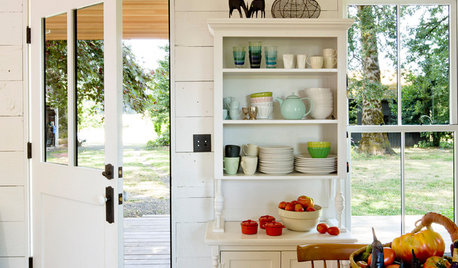Continuation of earlier thread:
I��m just addressing some of your answers to my questions.
I��ll get off track..so keep that in mind!
Right now lets talk about sealing walls.
Keep the wallpaper. Paint over it, of paper over it. But it is helping to keep air out of the rooms
You wrote:
Walls were blown with cellulose in 80��s and cellulose is visible in attic.
This makes me think that walls are without top plates. So the only thing slowing air movement
is the cellulose. Not stopping air movement in walls, but slowing it.
"In the bedroom where carpet was removed the gap where the toe (?) molding would go some mineral wool type insulation is visible."
This area is one of the areas that it would be worth while to air seal.On all walls.
While it may not be cost effective to try to seal air movement in walls, stopping air infiltration into the house at these areas is cost effective. To caulk, maybe using something to fill the gap like backer rods is fairly easy to do. Use butter knife or flat screwdriver to push the backer rod into this gap that will be covered once toe molding (or ���� round) is installed, will stop air from entering the room.
Just as the wallpaper keeps air movement down,moldings around doors or windows..even floor & ceiling moldings..IF they have paint that fills in the gaps then the paint is making the seal. But if the paint doesn��t fill up the gaps..then caulk.
If you stop and think about how houses were built at the date of this build, it gives you insight into where these houses leak. Individual boards nailed together rather than sheet goods like plywood & sheetrock that only have air leaks at edges or holes cut into them. By the very way older homes were constructed..they leak. Grand old homes..but leaky.
Don��t worry about making the house too tight..you could caulk for a few years before getting to that stage.
Moldings, even today, cover gaps between floors and walls at the bottom of the wall, and ceiling moldings at the top of walls. (SO & I call moldings, bath vent covers & supply & return grills hole cover uppers. ITRW..out of sight out of mind.)
IF you are removing moldings..sealing behind the moldings is best.
But..it��s a pita to remove moldings, and old moldings break easily.
So rather than remove moldings, it is easier to caulk them.
If moldings are in several pieces..like triple piece ceiling moldings, then caulking in between each piece of molding is necessary. Then the top of the molding is caulked to the ceiling, and the bottom of the molding to the wall. Always.. any cuts and all corners.
Floor moldings..same thing. Caulk individual pieces, then top of molding to the wall. However, something I��ve learned the hard way..caulking the bottom of the
molding to the floor creates another issue.
Caulk is an adhesive, and it dries but still stays pliable. That is the reason it is so good. It expands and contracts with the way the materials move.but it stays slightly tacky.
If you have pets indoors, their hair sticks to the caulk on the floor/wall area. At best it is difficult to clean. So if possible, remove lower portion of molding..esp if it is toe molding or ���� round. Fill the gap, caulk filler in place & replace the toe molding. Some areas will be a judgment call.
And always caulk cuts in corners. Ceiling, floor, door & window moldings.
Any area where different materials meet is potential for air leakage.
Keeping this in mind will help you to realize that there are areas while you are caulking that you will notice, that otherwise you would not have noticed.
There are indicators of air leaks also. Spiders build their webs where air moves.
Around plumbing penetrations under sinks, in window sills, at moldings at the ceiling.
Places that leak air that passes through porous materials..carpets & even insulation batts or blown insulation, will collect dust as the air moves thru the material. Dirty insulation hides a hole below it.
Carpet that is dirty around floor moldings hide that gap you saw in the room you removed carpet from. Dirty carpet under a door is lack of return air for forced air heating & cooling.
Look for clues for air leaks.
Just as you want to air seal the ceiling & floor moldings..the same things apply to window framing..aprons, sills and individual frame pieces.
I know you feel the air at the holes where the pulleys are, but there are air leaks that you won��t feel unless the house is depressurized. This happens ��sort of�� when the wind is strong.
As the wind blows against the house..you feel where it enters. Some of the areas anyway. Homeowners usually tell me about windows and weather-stripping of doors..because that is where they think to check. Just as the wind is pushing air into the house on the side the wind blows..it is doing the opposite on the opposite side of the house from the wind. If it is blowing in on the north side
it is sucking out on the south side. If you were outside on the south side, you��d feel the air exiting the house.
so things to use to seal..as you start weatherizing, you'll probably get inventive..I have. and discovered some great products.
here are some of them.
Backer rods are great..and caulk finishes the seal. Backer rods are round foam ..rods..pieces that come in a roll in a bag. Usually in the weatherization section of HD & Lowe��s. Grey foam that comes in different widths. ���� ���� etc.
The great thing about them is if the backer rod is too big..cut it to size with scissors. Stuff it in the gap, caulk it on both sides of the hole you are sealing.
At $3.00 a bag..you can do a lot. In my house, in the winter I stuff it between the window sections. When the weather is nice (early spring..early fall) I take it
out and open the windows.��
If gaps are too big say over ���� use backer rods. After caulk dries..in 24+ hours go back and look to see that it didn��t dry & shrink. If you caulk too big of an area the caulk will shrink as it dries. that��s ok..just check your work and recaulk.
I caulk with a wet washcloth because I��m a finger finisher with caulk. Wet finger run it along caulked area, wipe off excess. Just remember to rinse the wash cloth often or you��ll leave a caulk sheen on the area you are working on.
always invest in caulks with a long life. 25, 35 & 50 year caulks are a good investment. My go to caulk is Dap brand Alex caulk. Water based, easy clean up, Crystal Clear. Goes on white, dries clear.
Personally I think the person who invents a matt finish caulk will be a millionaire.
As it is, caulk is shiny when it is dry. Start in an area where you can determine if you are ok with the caulk. Don��t use colored or white caulk unless you are absolutely sure they match. Alex is paintable..just so you know. Buying contractor cases are the best price in my area.
Some areas you can��t fit a caulk gun into. HVAC supply stores sell Thumb Gum. This is a rope caulking. This works well around plumbing penetrations under sinks.
If you are really getting into the caulk journey having pieces of foam sheathing, like ���� dow blue board or cornings pink board work for larger areas.
These are easy to cut into sizes you need tap into place & caulk to seal.
Different holes will require different sealing methods.
Great Stuff..hardly ever use it. No control over how it goes into place. As it dries, it shrinks. As it gets older..it shrinks more. I think the only place I��ve used it recently was in a tree that the branch broke & a section rotted. Worked well there..after I caulked where it shrank to keep the water out of the tree trunk.
If you have an area where electricity or heat is involved..fire rated caulk or foam..if you are so inclined. Fire rated caulks are higher cost and the caulk is orange..same with fire rated caulks. Never use foam boards or backer rod & regular caulks at these electrical or heating areas.
I use a lot of ductboard..another HVAC product. Like foam sheathing boards it is easy to cut with a razor knife. Sometimes in a tight spot you don��t have room to maneuver to cut sheetrock, so ductboard is a good alternate. Doesn��t burn, just itchy to work with.
I use a razor knife with extendable (break off pieces when it gets dull) blades.
There are always places that leak that you wouldn��t think of. For instance,in my house, the false boxing above the kitchen cabinets were a big leakage.
They installed the boxing before finishing the ceiling, so behind the boxing was just leaky t&g ceiling. While I took some of the cabinets down, the rest presented two problems. To seal the air leaks, I caulked the trim moldings
top & bottom, then the sections of the boxing before painting.
Then I blower door tested (again) and found that the leakage was inside the cabinets at the top of the cabinet where the false boxing met the cabinet top.
Thumb gum that I mentioned above doesn��t work well in long stretches. Gravity works against it.
So I used a product also from HVAC supply. Hardcast #1402 brand mastic tape.
This stuff is GREAT. I can��t say enough good things about it. If surfaces are clean and dry..it sticks to everything. Well except stone and concrete. Metal to wood
glass to sheetrock..it is worth every penny of its somewhat expensive cost.
I pay about $21.00 a roll. 3�� wide..xxx feet long. Great for ductwork too.If you can't find it, shoot me an email & I'll give you the phone number of the place I order it.
I know we still have crawlspace & attic to deal with. But we will get to that too.
Its been a long mulching day for me. Three truckloads & still not done. Done for this weekend anyway!
Hope my rambling still got some information across.
Happy Vets weekend everyone.




















shesaidc2
liriodendron
Related Professionals
Ballenger Creek Kitchen & Bathroom Designers · Arcadia Kitchen & Bathroom Designers · Four Corners Kitchen & Bathroom Designers · Gainesville Kitchen & Bathroom Designers · Glens Falls Kitchen & Bathroom Designers · Hillsboro Kitchen & Bathroom Designers · Peru Kitchen & Bathroom Designers · Southbridge Kitchen & Bathroom Designers · Deerfield Beach Kitchen & Bathroom Remodelers · Glen Allen Kitchen & Bathroom Remodelers · Linton Hall Kitchen & Bathroom Remodelers · Shaker Heights Kitchen & Bathroom Remodelers · Arvada Architects & Building Designers · Rocky Point Architects & Building Designers · Nanticoke Architects & Building Designersenergy_rater_laOriginal Author
shesaidc2
energy_rater_laOriginal Author